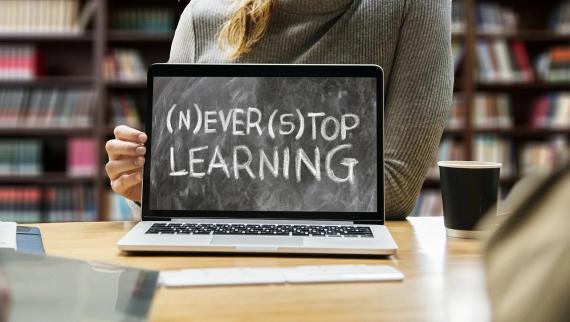The Novel Coronavirus is affecting people and institutions worldwide. The UW English department is obviously no exception. Our most major adjustment last spring quarter (and once again this fall quarter) has been teaching a full catalog of classes remotely. The English department’s response to this massive, short-order change has been impressively careful, ethical, and effective. It’s truly been an “all hands on deck” situation. And, to a person, the English Department has shown up topside.
With over 150 courses, the move to online/remote instruction was no small feat. Led by Professors Candice Rai, Megan Callow, Kimberlee Gillis-Bridges, and Michelle Liu; EWP coordinator Jake Huebsch; Digitial Pedagogy Consultants C.R. Grimmer and Ben Wirth; Computer Specialist Rob Weller; and Assistant Directors in the Expository Writing Program, we began at the end of winter and continued throughout the spring break by creating online teaching resources and assembling a digital pedagogy team to support faculty and instructors. The leadership team compiled a comprehensive guide that included instructional videos (created by C.R. Grimmer) and tips on how to use available tools to deliver lectures, lead discussions, conduct small group activities and peer review, hold virtual office hours, assign homework, give feedback, have students do presentations, etc. Throughout the term, the digital pedagogy team developed materials in response to emergent issues and questions, including how to think carefully about issues of access, attrition and retention, and equitable and responsible assessment. We also created a webpage that includes a list of community resources for students who need assistance. You can review the support resources we developed on our website at: https://english.washington.edu/online-teaching-and-research-support.
We also reallocated resources to make available three experienced digital pedagogy consultants (C.R. Grimmer, Jake Huebsch, and Ben Wirth) to provide quarter-long online teaching support, hold virtual office hours, and lead teaching teams. We also created a discussion list where faculty can ask each other questions, exchange ideas, and share practices, materials, and resources related to online and remote instruction. We designed surveys to gauge instructor equipment needs and upgraded older computer equipment for loaning, and we managed to shift our complex administrative infrastructure so it can function remotely. Department faculty and instructors have shown incredible professionalism and dedication to teaching, and our students have shown remarkable courage, flexibility, and resiliency in adapting to new conditions of learning.
English Matters would like to highlight the efforts that went into the rapid transition to online teaching from some of the colleagues who went to exceptional lengths in making that process successful: Associate Director of Writing Programs Michelle Liu, Assistant Directors of Digital Pedagogy Jake Huebsch, C.R. Grimmer, and Ben Wirth, and Director of the Computer Integrated Courses program Kimberlee Gillis Bridges.
1) Could you please relate your role in helping the UW English department transition to all remote instruction?



Ben Wirth (BW), Lecturer; Assistant Director of Digital Pedagogy: My role in helping the UW English department transition to online instruction has been twofold—providing support for faculty and graduate students making use of educational technologies and developing resources and best practices for online instruction. I've taught online courses in the past and have done some research in online learning, so this quarter has been a productive opportunity for applying that knowledge.


2) How has it been going? Can you characterize challenges? Successes?
ML: I have been so impressed by the myriad ways the 19 instructors I oversee have altered their classes to be sensitive to accessibility and equity issues. [Last spring] we all had only a week to design our courses around new technological tools and student time zone location, access to technology, and well-being. Everyone is mourning the loss of person-to-person contact, but overall, everyone has figured out methods to produce some facsimile of classroom community to support learning.
JH: It was a rapid start and even now, the greatest challenge I've felt is a constant need for nimbleness. I've been very fortunate to work closely with Candice Rai, [Interdisciplinary Writing Program Director] Megan Callow, [Department Chair] Anis Bawarshi, C.R. Grimmer, Ben Wirth and many others whose insights and wisdom have been invaluable at this time.
I've personally felt great success at connecting with and working closely with instructors. It's been so rewarding to support them and learn from them, hearing about the innovative adjustments to their class. From what I've heard, students and instructors are, overall, having positive experiences in their English classes. This is a testament to the care, effort and skill that the whole of the English Department has put into this transition and to the flexibility and patience our faculty and graduate instructors have practiced with this work.
CR: I’ve noticed people being extraordinarily collaborative and willing to hop in and help others at the last minute. Something we've done well I think is not a skill people associate with an English department or academia. That something is working together to create communication pieces that are produced and disseminated quickly and effectively. We’ve been really successful crowdsourcing information. I feel like we're doing a great job at working together. There's a very genuine desire to make materials accessible to students with disabilities, and problem solve around that. Our efforts in that regard have been a huge success. I've really enjoyed working with our faculty, and I've been really excited to be in a department where faculty are being so generous with each other.
BW: I think it’s been going well, and I think that’s largely due to the fantastic group I have worked with so far—Candice Rai, Anis Bawarshi, C.R. Grimmer, and Jacob Huebsch have brought so much energy and insight to the work we’ve been doing this quarter. I think a challenge has been understanding different student “incomes” for this quarter of online instruction. Typically, students who take online classes are choosing to take an online class, and there are tendencies with that demographic of students that most theories of online instruction are built around. This quarter is different, and it has required an adjustment to the way I think about online learning and its goals. However, a success for everyone in the English department has been in realizing how flexible our instruction can be, and I find myself constantly learning from the methods and experiences of others in our department.
KGB: Because I have students in very different time zones, my class combines asynchronous and synchronous activities. This type of course design gives students more due dates and times to track than they would have in a face-to-face course. Establishing a set pattern of dues dates/times has helped, as has checking in with students about how the schedule was working for them. We ended up altering due times to midnight to allow students more time to complete readings and screenings and thus produce more thoughtful work.
One significant challenge was the cancellation of the Seattle International Film Festival (SIFF), which students taking my spring film course always attend. In fact, I typically do online or hybrid instruction the last three weeks of spring to accommodate festival screenings. Fortunately, festivals and distributors have gotten creative with online options. SIFF Cinema has started virtual screenings, SXSW has partnered with Amazon to bring selections from that cancelled festival to Amazon Prime for free, and individual distributors have done online screenings that include live Zoom or social media Q&A.
As C.R. and Ben noted, students have had issues with spotty WiFi. One consequence is that not everyone can participate in live sessions via video. I’ve become acutely aware of how visual a person I am. I scroll through students’ Zoom video windows, looking for evidence of understanding or, “the face of confusion,” as I call it. I’ve leaned on Zoom’s chat and non-verbal feedback features, asking students to quickly indicate whether points are clear. While some students have found chat distracting as yet another window to track, most like the opportunity to pose quick questions and even give each other technical help during live discussions. When you have to unmute audio before speaking orally and your video window becomes larger when you’re talking, participating in class becomes more daunting than it otherwise would be. I think chat has given introverted students more of a voice in live discussions. When I return to face-to-face teaching, I may incorporate a chat backchannel into our discussions.
3) What have you done personally to manage the stress of the Department’s transition piled on top of it being a generally unsettling time?
ML: As for how my family is doing, luckily we are all fine. My kids are old enough (10 and 14 years old) to be independent enough to give me the work time when I need it, and young enough to enjoy hanging out with me. We bought a couple of cooperative board games at the start of shelter-in-place, one of which is called "Pandemic." It's turned into a great metaphor for how to weather the real-life pandemic. A perfect example of the importance of fiction in helping us imagine into being the reality that we want!
JH: I have a large whiteboard with all of the projects and notes I need to keep track of currently sitting in front of my dining room table (which doubles as my desk) and this has been so helpful in organizing my thoughts and tracking core projects amidst a barrage of emails and updates. I also have a piano right next to my desk so when I need a quick break, I practice a song.
I also actively work to be upfront and honest with everyone I am working with, checking in with how they are doing, both personally and professionally, and reporting out where I am at. I've found that learning how others are supporting themselves and sharing my own experiences has helped, to the small extent it can, reinforce the connections that I have with folks, even while I can't see them in person.
CR: In the first couple of weeks of the quarter I didn't have the greatest boundaries. I think I got over excited to produce materials. It was energizing and interesting doing urgent work helping so many teachers and students in a time of crisis. It also became a bit overwhelming, so I put some boundaries in place. Now Fridays are my “sacred days” when I work on my own stuff like professional development. So I think just kind of settling into the flow and knowing when to delegate and what to take it on has been a big part of self-care.
BW: What's been helping me manage stress is to try to keep work time and leisure time separate, and I’ve tried to avoid the work-from-home trap of letting them bleed into each other. I learned in quarters past that keeping a dedicated space and time for my work/Zoom hours and a dedicated space and time specifically for not doing work helps to keep things compartmentalized—our classes being online does not mean that we always must be. That and not working in pajamas.
KGB: My house has become an office to two adults and a school for an adolescent. I’m trying to maintain a healthy diet, get outdoors every day, and find five minutes to breathe deeply. All of these efforts work against my ingrained tendencies to complete just one more task before settling work for the day and putting off physical activity until an unspecified “later.” Reading C.R.’s and Ben’s responses confirms I have much to learn.
We already know this, but our students are amazing. They have lost so much—jobs, graduation ceremonies, sports seasons, study abroad experiences. They’ve taken on new responsibilities, including caring for family members. Everyone is overwhelmed. Yet, my students have been so open to intellectually and emotionally engaging one another via platforms that can seem distancing and invasive by turns. They’re willing to experiment with me to see if a new method will work. None of what we do could happen without them.
